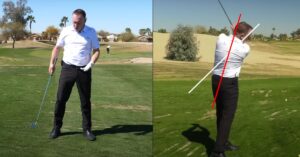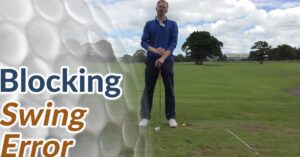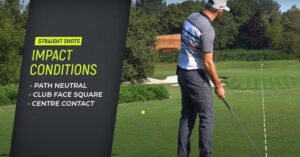Why Do I Hit Fat Golf Shots? Techniques For Better Contact with Ball
Fat shots are a common problem for many golfers and can be frustrating. Hitting the ground before the ball can result in a loss of distance and accuracy. So, why do golfers hit fat shots?
In short, there are a number of reasons why golfers hit fat shots. The most common reasons include not shifting weight properly, not keeping the spine angle consistent, not hitting the ball in the center of the clubface, and swinging too hard.
In this blog post, we will delve into why golfers often hit fat shots and provide valuable tips to help you overcome this common problem.
Why Do I Hit Fat Golf Shots? Understanding The Problem

Fat shots occur when the club strikes the ground before the ball, resulting in power, accuracy, and distance loss. Factors include poor weight distribution, posture, and steep swings.
Let’s explore each factor and learn how to rectify them for a better golfing experience.
Poor Weight Transfer And Balance
One common reason for hitting fat shots is an improper weight transfer during the swing. If your weight remains on the back foot or shifts forward too early, it can cause you to hit the ground before the ball.
To correct this, focus on maintaining a balanced and athletic stance throughout your swing, shifting your weight smoothly from your back foot to your front foot as you make contact with the ball.
Incorrect Ball Position
The position of the golf ball in relation to your stance is crucial. Placing the ball too far back in your stance can cause you to hit the ground early, resulting in a fat shot.
Conversely, if the ball is too far forward, you may make contact with the ball before reaching its lowest point in the swing arc.
Experiment with ball positions during practice sessions to find the optimal placement that allows you to strike the ball cleanly.
Insufficient Arm Extension
Lack of proper arm extension through impact can lead to fat shots. If your arms collapse or bend prematurely, it can cause the clubhead to bottom out before reaching the ball.
Work on maintaining good extension and a straight leading arm throughout the downswing and at impact. This will ensure that the club strikes the ball cleanly without hitting the ground first.
Early Release Of The Club
Releasing the club too early in the downswing can result in hitting fat shots.
An early release causes the clubhead to descend steeply, leading to an improper strike. Focus on maintaining lag in your swing, allowing the clubhead to lag behind your hands until the last moment before impact.
This helps promote a shallower angle of attack and reduces the chances of hitting the ground before the ball.
Lack Of Practice And Technique
Lastly, hitting fat shots can be a result of inadequate practice and improper technique.
Regularly practicing your swing, including proper weight transfer, ball position, and arm extension, will improve your consistency and minimize fat shots.
Consider seeking guidance from a golf instructor who can analyze your swing and provide specific feedback to address any technical issues.
How To Fix Fat Golf Shot

However, with a few adjustments to your setup, swing, and focus, you can fix this issue and improve your ball-striking consistency. Here are some steps to help you fix your fat golf shots
Evaluate Your Setup
Before addressing your swing mechanics, ensure that your setup is correct. Check your posture, alignment, and ball position to ensure they are in the proper position.
Maintain A Steady Head Position
One common cause of fat shots is lifting or moving the head during the swing. Focus on keeping your head steady throughout the swing to promote solid contact.
Shift Your Weight Properly
During your swing, transfer your weight from your back foot to your front foot. This weight shift helps create a downward strike on the ball and prevents hitting behind it.
Focus On Ball-First Contact
Train your mind to focus on hitting the ball first, rather than the ground. Visualize striking the ball cleanly and try to make contact with the ball before the club reaches the ground.
Practice With Proper Divot Patterns

Aim to create divots after the ball rather than before it. This indicates that you are striking the ball first and then taking a divot, which is the desired impact position.
Control Your Swing Tempo
A rushed or overly aggressive swing can lead to fat shots. Focus on maintaining a smooth and balanced tempo throughout your swing to promote solid contact with the ball.
Experiment With Club Selection
If you consistently hit fat shots with certain clubs, try using a higher lofted club or a different club altogether. Sometimes, a slight adjustment in club selection can help improve contact.
Seek Professional Guidance
If you’re struggling to fix your fat shots, consider seeking help from a golf instructor. They can analyze your swing mechanics and provide personalized guidance to address your specific issues.
Tips And Drills To Correct Fat Shots In Golf
Fat shots are a common problem for many golfers. Fortunately, there are several tips and drills that golfers can use to correct this issue and improve their game.
Check Your Set-Up
A common cause of fat shots is an improper set-up. Make sure your feet, hips, and shoulders are aligned properly, and your weight is evenly distributed.
Use The Right Club
Using the wrong club can cause fat shots. Make sure you’re using the appropriate club for the shot you’re trying to make.
Focus On Your Swing
Swinging too hard or too fast can cause fat shots. Focus on making a smooth and controlled swing, and avoid trying to hit the ball too hard.
Practice With A Towel
Practicing with a towel can help you avoid hitting fat shots. Place a towel about an inch behind the ball, and practice hitting the ball without touching the towel.
Work On Your Weight Transfer
Shifting your weight too far back on the downswing can cause fat shots. Work on transferring your weight smoothly from your back foot to your front foot as you swing.
Get Feedback From A Pro
If you’re still struggling with fat shots, consider getting feedback from a golf pro. They can help you identify any issues with your technique and provide personalized tips to help you improve.
Frequently Asked Questions
Golfers often struggle with hitting fat shots, where the club strikes the ground before making contact with the ball. This can result in a loss of distance and accuracy.
Here aresome requently asked questions about why you hit fat golf shots, answered clearly.
Why Is My Swing Too Steep?
A steep swing path occurs when you bring the club down at a steep angle, causing it to strike the ground before reaching the ball. This can happen due to improper body positioning, a lack of wrist hinge, or an overactive upper body during the swing.
How Does Poor Weight Transfer Affect My Shots?
If your weight remains on your back foot during impact, it can lead to fat shots. Insufficient weight transfer prevents you from striking the ball first and causes the club to hit the ground too early. Focus on shifting your weight forward as you swing to improve your contact.
What Role Does Ball Position Play In Fat Shots?
Incorrect ball position can contribute to hitting fat shots. Placing the ball too far back in your stance makes it more likely for the club to hit the ground early.
Experiment with ball placement, ensuring it is positioned slightly ahead of center for irons and hybrids.
How Does Lack Of Clubhead Speed Affect My Shots?
When you lack clubhead speed, the club may not have enough momentum to strike the ball cleanly.
This can lead to hitting the ground before making contact. Working on increasing your clubhead speed through proper body rotation and a relaxed swing can help mitigate fat shots.
How Does Poor Technique Contribute To Fat Shots?
Various technical flaws can result in fat shots, such as an early release of the wrists or casting the club too early.
These errors cause the club to bottom out before reaching the ball. Focusing on maintaining proper sequencing and timing in your swing can help prevent fat shots.
Conclusion
Fat shots in golf can be frustrating, but they are a common problem with various causes. By understanding the factors that lead to fat shots, such as poor weight distribution, incorrect ball position, and early release of the club, golfers can make the necessary adjustments to improve their contact with the ball.
With practice, proper technique, and perhaps the guidance of a golf instructor, you can overcome fat shots and enhance your overall game.
Keep working on your swing and enjoy the rewards of improved ball-striking consistency.

![Does 1 Degree Lie Angle Make Difference In Golf Shots? [Explained] Does 1 Degree Lie Angle Make Difference In Golf Shots? [Explained]](https://giftedgolfers.com/wp-content/uploads/2023/05/image-112-1024x538.png)


![How Not to Shank the Golf Ball? [Try These Tips And Tricks] how-not-to-shank-the-golf-ball](https://giftedgolfers.com/wp-content/uploads/2023/05/how-not-to-shank-the-golf-ball-300x157.jpg)

